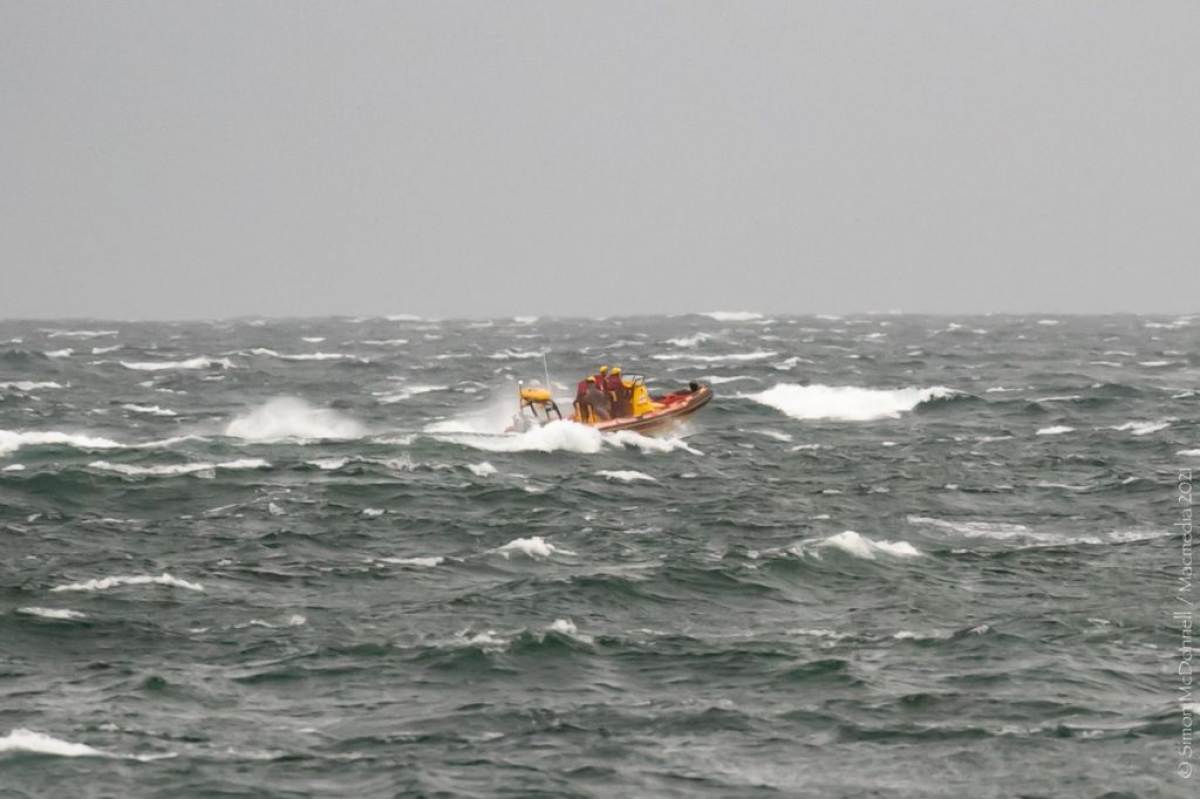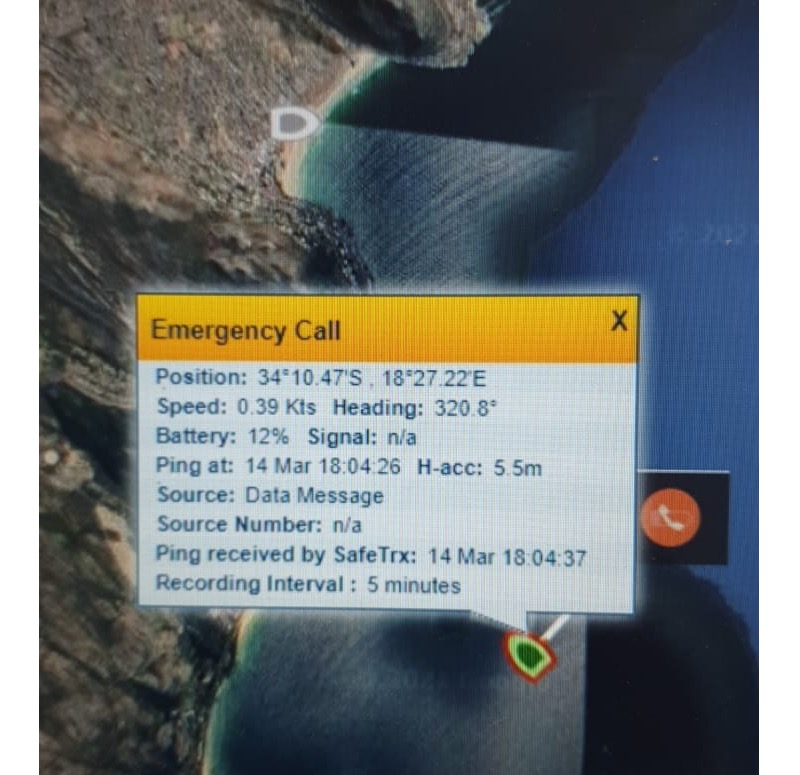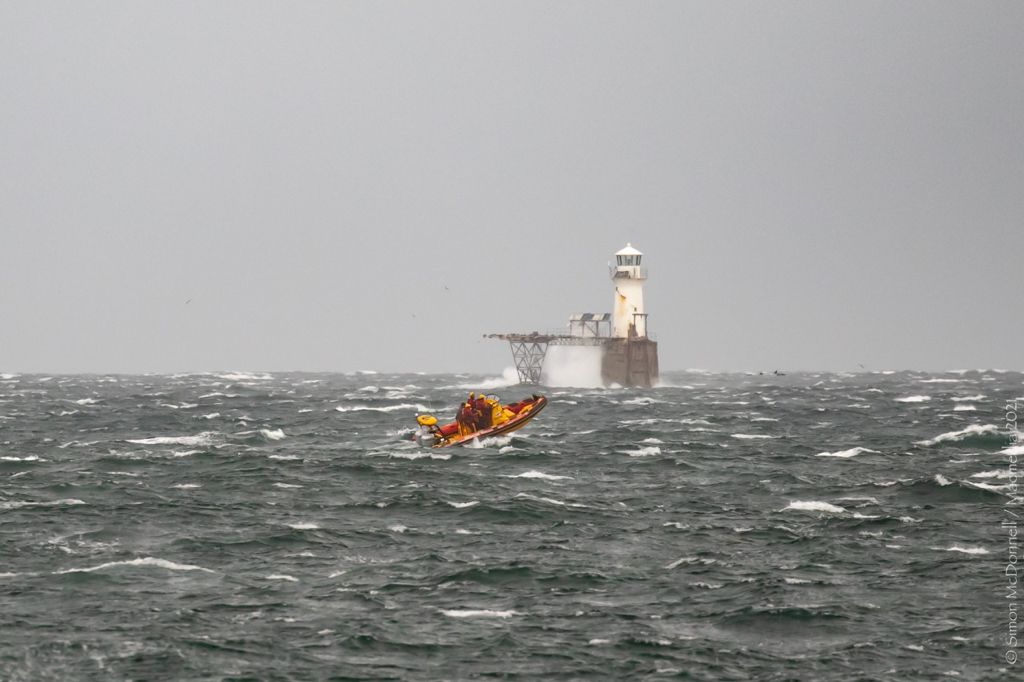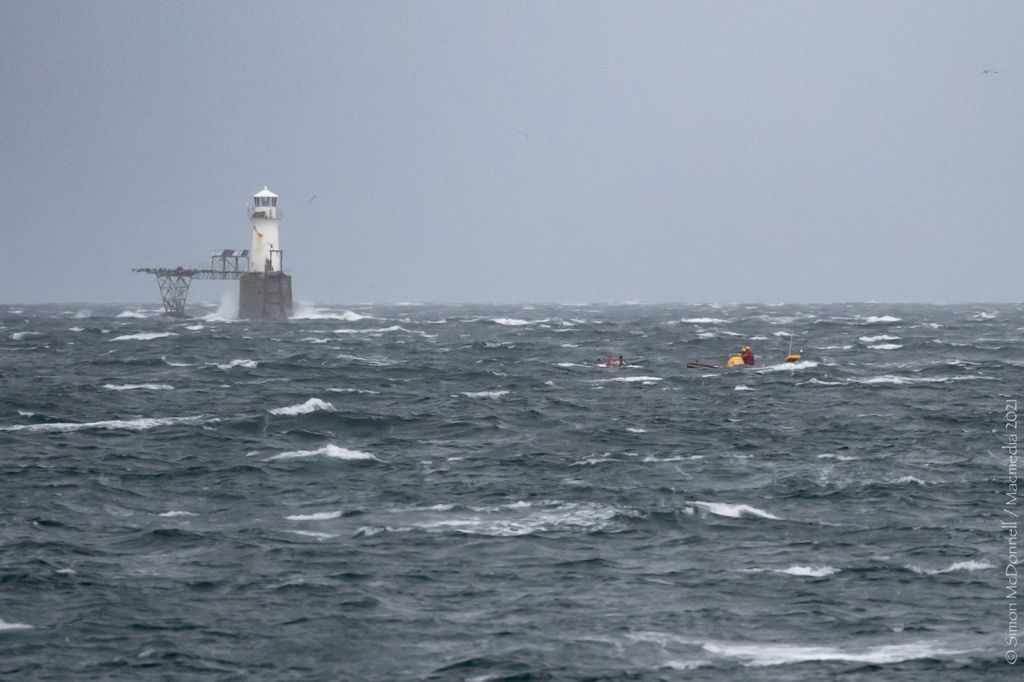“Not a Standard Miller’s!” – A Rescue Story
 The NSRI's "Spirit of Surfski II" RIB heads out to sea in 30kt of southeaster
Credits: Simon McDonnell
The NSRI's "Spirit of Surfski II" RIB heads out to sea in 30kt of southeaster
Credits: Simon McDonnell
It’s not easy to catch a rolling, runaway single ski in 30kt of gusting wind – and as they attempted to grab it, Alex and his doubles partner lost their balance and fell into the water. By the time they’d remounted, the single ski was gone – blown away by the strengthening near-gale. They turned and paddled back upwind to find their buddy.
First-timers
Alex Topliss and his friends had been planning the paddle for a while and finally the forecast seemed perfect: the predicted 20-25kt southeasterly should give exactly the right conditions for a first-time Miller’s Run. Not that it was the first time for Alex; growing up in Fish Hoek, he’d done countless of the runs, but he was eager to share the route with his friends, who’d all been paddling for a year or more, but who hadn’t had the opportunity to do the famous (infamous?!) route themselves.
Three of them would be on single skis, while Alex took a double with a fourth neophyte.
Prep
At Miller’s Point, Alex pre-flighted the others, making sure that they all had leashes and mobile phones and that they knew the route: launching at the south ramp, they’d paddle out to the traditional start at Bakoven Rock before heading downwind to Fish Hoek via Roman Rock Lighthouse.
Alex knew that they were all competent paddlers – and, importantly, had practiced deep-water remounts. They were to try to stick together.
When they attempted to start the SafeTrx tracking app on their phones, however, they struggled. The mobile signal at Miller’s Point isn’t good at the best of times and there was an electricity blackout (“load shedding”) which can cause further signal degradation – not all cell towers are equipped with standby generators.
Tentative
The 800m paddle out to Bakoven Rock is intimidating: the ramp is situated in Rumbly Bay, named for the pebble beach that literally rumbles as the waves strike the pebble shore. In big conditions, the waves rear up, threatening to break and close out across the mouth of the bay.
Happily, on this day it wasn’t that gnarly, but the conditions are always tricky as you paddle diagonally into the wind and waves with breakers smashing into rocks of Miller’s Point itself to leeward and Alex could sense his friends were tentative as they made their way out.
The group had agreed that the faster double would start after the single skis in order to sweep behind them.
First Swim
At the rock Alex hit the start button on his Garmin. It was 17h08 – with sunset at 19h06, they should easily have an hour to spare…
But they’d barely gone a kilometer when Alex heard a yell: Chris, one of his buddies, was swimming in the water and had lost his ski, which had already rolled some 30m away from him.
Steering towards it, the pair managed to come alongside and grab it. Briers, the paddler in the back, got into it.
“You’re always a bit shaken when you swim,” says Alex, “so Briers stayed in the single, and I put Chris in the back of the double.”
Settling down, the three men headed off again towards the lighthouse. A little while later, Briers lost his balance and fell off the single ski. His remount was quick, and they set off again.
In the meantime, the lead pair of singles had vanished and made their way successfully to Fish Hoek.
And then…
Roman Rock Lighthouse is the iconic symbol of the Miller’s Run. The rocks lie some 2km directly offshore from Simon’s Town and 5km from Fish Hoek. Seaward of the lighthouse, a reef breaks when the waves are big – and you can shoot a gap between the reef and the lighthouse - if you know where to go.
The roller coaster ride near the lighthouse adds a fillip to the adrenalin; as you surf past, you hit reflected waves coming off the base of the lighthouse, fantastic fun…
For Alex and his mates though, a km past the lighthouse, the fun stopped abruptly.
“The wind had picked up quite a bit,” says Alex. “Briers fell off again – and his boat shot away. We tried to grab it but ended up swimming ourselves.”
By the time the two men had remounted the double ski, the single had disappeared, carried off by the wind and breaking waves.
Paddling back upwind, they came alongside Briers. By now it was nearly 6pm and the light was beginning to fade. Although the water was relatively warm (19C in False Bay), it wouldn’t be long before they started to get cold. It was time to call for help.
Emergency Calls
“We took our phones out and tried to activate SafeTrx,” says Alex. “It didn’t seem to work, so I tried to call my mom. I couldn’t get through to her so then I tried calling Dawid Mocke. That didn’t work either!
“Finally, I was able to get through to the NSRI emergency number and told them that we were 4km off Glen Cairn in line with the lighthouse.”

The SafeTrx Notification on the NSRI Ops Room Computer
SafeTrx Notification
When the emergency button on SafeTrx is pressed, two things happen: the app itself sends an emergency message AND it attempts to make a phone call to the rescue authorities (here in South Africa, that’s the NSRI).
Unknown to the three men, although they didn’t think they’d successfully triggered the emergency, the app had in fact sent a notification, which the NSRI received at 18h05
So, when Alex dialed the NSRI number himself and got through to them, NSRI already had his position, thanks to the SafeTrx message.
The NSRI Emergency Operations Centre alerted the nearest Sea Rescue base – in Simon’s Town - and they commenced their activation procedures.
“Eyes On”
Knowing approximately where the paddlers were, the NSRI sent a shore crew to a point on the road with a view of the area. Scanning with binoculars, they spotted the double ski just north of the lighthouse. In addition the NSRI sent out a message to a group of coastwatchers and within moments, half a dozen more volunteers, most of whom live on the heights above Simon's Town were also scanning the ocean. "Whenever we get a call out," says Station Commander Darren Zimmerman, "we message our coast watchers. Their information comes into the control room and they can be very effective."
With the guidance of the shore crew, the Spirit of Surfski II RIB was able to speed directly to the double’s location.
Although it felt like an age to the three men, in fact the rescue was remarkably fast. From the time Sea Rescue Simon’s Town was activated to the point where Chris was lifted from the water, less than 25min had elapsed.
“I was beginning to feel a bit chilly,” says Alex. “I’d put Briers in the back of the double and told Chris to lie on the back deck.
“We’d started to try and steer towards Fish Hoek when the NSRI arrived.”

"Spirit of Surfski II" near the Roman Rock Lighthouse
“SafeTrx takes the ‘search’ out of Search and Rescue”
Chris boarded the RIB while Alex and Briers paddled on downwind to Fish Hoek.
A little while later, the missing surfski came ashore on the rocks near Glen Cairn and was recovered without damage.
The NSRI commended the three for staying calm, using SafeTrx and for staying together.
So why write about this almost non-event of a rescue?
Conclusions
SafeTrx was critical to the quick resolution of this rescue. Ironically, the paddlers weren’t even aware that they’d successfully triggered the emergency button in the app.
SafeTrx needs a good data connection to the mobile network in order to start tracking. The mobile signal at Miller’s Point is notoriously bad and it’s recommended that paddlers start the app while they’re still at Fish Hoek, before driving to Miller’s Point.
SafeTrx uses little battery or data, so there’s no drawback to starting it early.

Spirit of Surfski II and the Double Ski
As summer draws to an end, the thorny issue of launch times must also be considered.
Time, in Search and Rescue, is of the essence.
Every rescue can be broken into three phases:
- NSRI crews are volunteers, they don’t live on-base and have to be summoned. It takes time for them to drive from their nearby homes to the base, to change into their gear and then to launch boats.
- Transit: Ideally the crew knows where to go, thanks to SafeTrx, and can proceed to the area where the emergency has occurred. The transit time depends on the weather and which craft are involved.
- Search: It may not be possible for the crew to follow SafeTrx directly to the exact point – on the RIB for example, there is not computer screen. And in really rough weather, a surfski or especially a swimmer – can be extremely difficult to spot even 50m away. So even though the rescue boat has reached the approximate position, they may still have to search the nearby area to find the casualty. Finding a swimmer at night is exponentially more difficult.
In this case, while the rescue was accomplished extremely rapidly, there was barely half an hour of daylight left by the time the RIB reached the paddlers.
Finally, there’s the issue of leashes. Both Chris and Briers’ leashes failed. Neither leash broke, but neither secured the surfski when they fell off.
- Make sure the leash is attached properly to an anchor point on the surfski.
- Understand that it could break and make sure that you’ve though about what you’d do if it did.
- If you do fall off, respond as though you don’t have a leash at all, and don’t let go of the boat.
As always – a huge thank you to our guardian angels in the NSRI!

